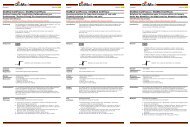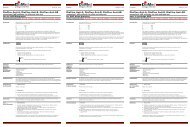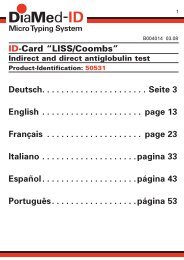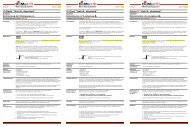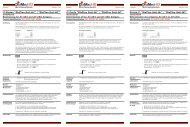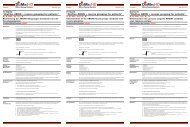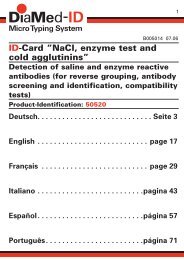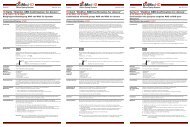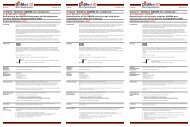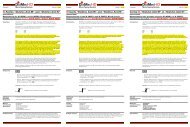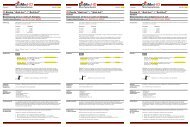ID-Cards “Anti-K“ / “Anti-k“
ID-Cards “Anti-K“ / “Anti-k“
ID-Cards “Anti-K“ / “Anti-k“
Create successful ePaper yourself
Turn your PDF publications into a flip-book with our unique Google optimized e-Paper software.
Deutsch B002111 07.07 English B002111 07.07 Français B002111 07.07<br />
<strong>ID</strong>-Karten <strong>“Anti</strong>-<strong>K“</strong> / <strong>“Anti</strong>-<strong>k“</strong><br />
human<br />
Bestimmung der Kell- und Cellano-Antigene<br />
Produkt-Identifikation: K: 50190 / k: 50260<br />
<strong>ID</strong>-<strong>Cards</strong> <strong>“Anti</strong>-<strong>K“</strong> / <strong>“Anti</strong>-<strong>k“</strong><br />
human<br />
Determination of the Kell- and Cellano Antigens<br />
Product-Identification: K: 50190 / k: 50260<br />
Cartes-<strong>ID</strong> <strong>“Anti</strong>-<strong>K“</strong> / <strong>“Anti</strong>-<strong>k“</strong><br />
humain<br />
Détermination des antigènes Kell et Cellano<br />
Identification de produit: K: 50190 / k: 50260<br />
Einleitung<br />
Es ist bekannt, dass das Kell-System (ISBT Nummer 006) 25 Antigene enthält, nummeriert<br />
von K1 bis K28 (wobei K8, K9 und K15 inzwischen obsolet sind).<br />
Introduction<br />
The KEL (Kell) system (ISBT number 006) is currently known to contain 25 antigens,<br />
numbered K1 to K28 (K8, K9 and K15 are now obsolete).<br />
Introduction<br />
Le système Kell (ISBT numéro 006) est connu pour contenir 25 antigènes, numérotés K1<br />
à K28 (exceptés K8, K9 est K15 qui ne sont plus utilisés).<br />
Nach Mollison [1] sind die Phänotypen der antithetischen Antigene K (KEL1) und k (KEL2)<br />
in der kaukasischen Bevölkerung mit folgender Häufigkeit anzutreffen:<br />
According to Mollison [1], the phenotype frequencies of the antithetical antigens K (KEL1)<br />
and k (KEL2) in the Caucasian population are as follows:<br />
Selon Mollison [1], la fréquence des phénotypes des antigènes antithétiques K (KEL1) et k<br />
(KEL2) dans la population caucasoïde est la suivante:<br />
KK . . . . . . . . . . . . . . . 0,2%<br />
Kk . . . . . . . . . . . . . . . 8,8%<br />
kk . . . . . . . . . . . . . . . 91,0%<br />
KK . . . . . . . . . . . . . . . 0,2%<br />
Kk . . . . . . . . . . . . . . . 8,8%<br />
kk . . . . . . . . . . . . . . . 91,0%<br />
KK . . . . . . . . . . . . . . . 0,2%<br />
Kk . . . . . . . . . . . . . . . 8,8%<br />
kk . . . . . . . . . . . . . . . 91,0%<br />
Die Antikörper des Kell-Systems können verantwortlich sein für hämolytische<br />
Transfusionsreaktionen (HTR) und für die hämolytische Erkrankung bei Neugeborenen<br />
(HEN).<br />
The antibodies of the Kell system have been associated with transfusion reactions and<br />
haemolytic disease of the newborn (HDN).<br />
Les anticorps du système Kell ont été associés à des réactions transfusionelles et à la<br />
maladie hémolytique du nouveau-né.<br />
Wegen der klinischen Bedeutung des Anti-K ist eine systematische Bestimmung der<br />
Kell- und Cellano-Antigene bei Spendern und Patienten angezeigt. Die <strong>ID</strong>-Karten <strong>“Anti</strong>-K”<br />
und <strong>“Anti</strong>-k” können zur Bestimmung des Antigens beim Spenderblut vor der<br />
Kreuzprobe, zur Bestätigung des Antigens nach Antikörper-Identifizierung oder zum<br />
väterlichen oder foetalen Antigentest bei alloimmunisierten Schwangerschaften<br />
verwendet werden.<br />
The clinical importance of anti-K has resulted in the systematic determination of the Kell<br />
and Cellano antigens in both donors and patients. The <strong>ID</strong>-<strong>Cards</strong> <strong>“Anti</strong>-K” and <strong>“Anti</strong>-k”can<br />
be used to determine the antigen status of donor blood prior to crossmatching, for<br />
confirmation of the antigen after antibody identification, or for paternal/fetal antigen<br />
typing in allo-immunised pregnancies.<br />
L’importance clinique de l’anti-K nécessite la détermination systématique des antigènes<br />
Kell et Cellano chez les donneurs et les patients. Les cartes-<strong>ID</strong> <strong>“Anti</strong>-K” et <strong>“Anti</strong>-k”<br />
permettent de déterminer l’antigène dans le sang du donneur avant de procéder au test<br />
de compatibilité, pour confirmer l’antigène dans le sang du patient après une<br />
identification d’anticorps ou pour déterminer l’antigène du sang paternel et foetal d’une<br />
grossesse alloimmunisée.<br />
Mit den <strong>ID</strong>-Karten <strong>“Anti</strong>-K” und <strong>“Anti</strong>-k” können sechs Proben gleichzeitig getestet<br />
werden.<br />
The <strong>ID</strong>-<strong>Cards</strong> <strong>“Anti</strong>-K” and <strong>“Anti</strong>-k” allow testing of six samples simultaneously.<br />
Les cartes-<strong>ID</strong> <strong>“Anti</strong>-K” et <strong>“Anti</strong>-k” permettent de tester 6 échantillons simultanément.<br />
Reagenzien<br />
Reagents<br />
Réactifs<br />
• <strong>ID</strong>-Karte <strong>“Anti</strong>-K” enthält 6 Mikroröhrchen mit polyklonalen Antikörpern Anti-K aus<br />
humanem Serum in der Gelmatrix. Konservierungsmittel: < 0,1% NaN 3 .<br />
• <strong>ID</strong>-Card <strong>“Anti</strong>-K” with 6 microtubes containing polyclonal anti-K antibodies from human<br />
serum within the gel matrix. Preservative: < 0,1% NaN 3 .<br />
• Carte-<strong>ID</strong> <strong>“Anti</strong>-K” avec 6 microtubes contenant des anticorps polyclonaux anti-K<br />
provenant de sérum humain inclus dans le gel. Conservateur: < 0,1% NaN 3 .<br />
• <strong>ID</strong>-Karte <strong>“Anti</strong>-k” enthält 6 Mikroröhrchen mit polyklonalen Antikörpern Anti-k aus<br />
humanem Serum in der Gelmatrix. Konservierungsmittel: < 0,1% NaN 3 .<br />
• <strong>ID</strong>-Card <strong>“Anti</strong>-k” with 6 microtubes containing polyclonal anti-k antibodies from human<br />
serum within the gel matrix. Preservative: < 0,1% NaN 3 .<br />
• Carte-<strong>ID</strong> <strong>“Anti</strong>-k” avec 6 microtubes contenant des anticorps polyclonaux anti-k<br />
provenant de sérum humain inclus dans le gel. Conservateur: < 0,1% NaN 3 .<br />
Warnung: Die Ausgangsmaterialien, aus denen dieses Produkt hergestellt wurde, hat sich<br />
bei der Prüfung mit zugelassenen Reagenzien als nicht reaktiv für HBsAg, HCV und HIV<br />
(1 und 2) erwiesen. Kein verfügbares Testverfahren kann jedoch die Gewähr dafür bieten,<br />
dass keine infektiösen Substanzen vorliegen. Aus Humanblut gewonnene<br />
Produkte sollten immer als potentiell infektiös angesehen werden.<br />
Caution: the source materials from which these products were manufactured, were found<br />
non reactive for HBsAg, HCV and HIV (1+2) when tested with licensed reagents.<br />
However, no known test method can assure that infectious agents are absent. Products<br />
from human blood should be considered potentially infectious.<br />
Attention: Les matières utilisée pour la fabrication de ces produits n’ont montré aucune<br />
réaction lors des dépistages de l’AgHBs, HIV1, HIV2 et HCV avec des réactifs agréés.<br />
Cependant aucune des méthodes connues ne peut assurer l’absence des agents<br />
infectieux. Les produits ayant pour origine du sang humain doivent être considérés<br />
comme des produits potentiellement infectieux.<br />
<br />
Stabilität: siehe Verfallsdatum auf dem Etikett.<br />
<br />
Stability: see expiry date on label.<br />
<br />
Stabilité: voir date de péremption sur l’étiquette.<br />
Zusätzlich<br />
benötigte<br />
Reagenzien<br />
<strong>ID</strong>-Diluent 1: Modifizierte Bromelin-Lösung zur Herstellung der Erythrozytensuspensionen.<br />
(siehe diesbezügliche Packungsbeilage)<br />
Additional<br />
reagents<br />
required<br />
<strong>ID</strong>-Diluent 1: modified bromelin solution for red cell suspensions.<br />
(see related package insert)<br />
Réactifs<br />
supplémentaires<br />
néccessaires<br />
<strong>ID</strong>-Diluent 1: solution de broméline modifiée pour suspensions d’hématies.<br />
(voir mode d’emploi correspondant)<br />
Weitere<br />
erforderliche<br />
Materialien<br />
• <strong>ID</strong>-Dispenser<br />
• <strong>ID</strong>-Pipetor<br />
• <strong>ID</strong>-Tips (Pipettenspitzen)<br />
• Suspensionsröhrchen<br />
• <strong>ID</strong>-Arbeitsplatz<br />
• <strong>ID</strong>-Zentrifuge 6, 12 oder 24<br />
Further<br />
materials<br />
required<br />
• <strong>ID</strong>-Dispenser<br />
• <strong>ID</strong>-Pipetor<br />
• <strong>ID</strong>-Tips (pipetor tips)<br />
• Tubes for suspensions<br />
• <strong>ID</strong>-Working table<br />
• <strong>ID</strong>-Centrifuge 6, 12 or 24<br />
Matériaux<br />
supplémentaires<br />
nécessaires<br />
• <strong>ID</strong>-Dispenser<br />
• <strong>ID</strong>-Pipetor<br />
• <strong>ID</strong>-Tips (cônes pour pipette)<br />
• Tubes pour suspensions<br />
• <strong>ID</strong>-Table de travail<br />
• <strong>ID</strong>-Centrifuge 6, 12 ou 24<br />
Probenmaterial<br />
Für verlässliche Resultate sollte die Bestimmung mit frisch abgenommenen Proben<br />
durchgeführt werden oder in Übereinstimmung mit lokalen Laborvorschriften für die<br />
Akzeptanz von Probenmaterial erfolgen. Vorzugsweise sollte die Probengewinnung in den<br />
Antikoagulantien Citrat, EDTA oder CPD-A erfolgen. Native Proben (kein Antikoagulanz)<br />
können auch verwendet werden.<br />
Sample material<br />
For optimal results, the determination should be performed using a freshly drawn<br />
sample, or in accordance with local laboratory procedures for sample acceptance criteria.<br />
Preferably, blood samples should be drawn into citrate, EDTA or CPD-A anticoagulant.<br />
Samples drawn into plain tubes (no anticoagulant) may also be used.<br />
Echantillons<br />
Afin d’obtenir des résultats fiables, la détermination devrait se faire sur du matériel<br />
fraîchement prélevé ou conforme aux exigences du laboratoire auquel la demande<br />
d’analyses est adressée. L’échantillon devrait être prélevé de préférence sur anticoagulant<br />
citrate, EDTA ou CPD-A. Du sang prélevé sans anticoagulant (natif) peut également être<br />
utilisé.<br />
Vorbereitung<br />
der Blutprobe<br />
Eine 5%ige Erythrozytensuspension in <strong>ID</strong>-Diluent 1 wie folgt herstellen:<br />
Diluent vor Gebrauch auf Raumtemperatur bringen.<br />
Preparation of<br />
blood sample<br />
Prepare a 5% red cell suspension in <strong>ID</strong>-Diluent 1 as follows:<br />
Allow the diluent to reach room temperature before use.<br />
Préparation de<br />
l’échantillon<br />
de sang<br />
Préparer une suspension d’hématies à 5% en <strong>ID</strong>-Diluent 1 comme suit:<br />
Ramener le diluant à température ambiante avant utilisation.<br />
1. 0,5 mL <strong>ID</strong>-Diluent 1 in ein sauberes Röhrchen pipettieren.<br />
2. 50 µL Vollblut oder 25 µL Erythrozytenkonzentrat zugeben, leicht mischen.<br />
3. Die Erythrozytensuspension 10 Minuten bei Raumtemperatur (18-25 °C) inkubieren.<br />
1. Dispense 0,5 mL of <strong>ID</strong>-Diluent 1 into a clean glass tube.<br />
2. Add 50 µL of whole blood or 25 µL of packed cells, mix gently.<br />
3. Incubate for 10 minutes at room temperature (18-25 °C).<br />
1. Distribuer 0,5 mL d’<strong>ID</strong>-Diluent 1 dans un tube propre.<br />
2. Ajouter 50 µL de sang total ou 25 µL de culot d’hématies, mélanger doucement.<br />
3. Incuber 10 minutes à température ambiante (18-25 °C).<br />
Innerhalb von 15 Minuten nach der Inkubation verwenden.<br />
Use within 15 minutes after incubation.<br />
La suspension d’hématies est à utiliser dans les 15 minutes qui suivent l’incubation.<br />
Kontrollen<br />
Bekannte Antigen-positive und -negative Erythrozyten sollten in Übereinstimmung mit<br />
den gültigen Richtlinien zur Qualitätssicherung mitgeführt werden.<br />
Controls<br />
Known positive and negative samples should be included in accordance with the relevant<br />
guidelines of quality assurance.<br />
Contrôles<br />
Des échantillons positifs et négatifs connus devront être inclus en concordance avec les<br />
réglementations régissant l‘assurance qualité.
Français B002111 07.07 English B002111 07.07 Deutsch B002111 07.07<br />
Méthode<br />
Ne pas utiliser les cartes <strong>ID</strong> présentant des signes de desséchement, des bulles d‘air dans<br />
le gel, un système de fermeture endommagé, des goutelettes de gel ou de surnageant<br />
sur les paroies supérieures des micotubes ou sur la face interne de la languette<br />
d‘aluminium.<br />
Test procedure<br />
Do not use <strong>ID</strong>-<strong>Cards</strong> which show signs of drying, have bubbles, damaged seals, drops of<br />
gel or supernatant in the upper part of the microtubes or on the underside of the<br />
aluminium foil.<br />
Testdurchführung<br />
Keine <strong>ID</strong>-Karten benutzen mit Anzeichen von Austrocknung, Luftblasen, beschädigter<br />
Versiegelung oder Tropfen des Gels bzw. des Überstandes im oberen Teil der<br />
Mikrokammer oder auf der Unterseite der Versiegelung.<br />
Ramener les cartes-<strong>ID</strong> à température ambiante avant utilisation.<br />
Allow <strong>ID</strong>-<strong>Cards</strong> to reach room temperature before use.<br />
<strong>ID</strong>-Karten vor Gebrauch auf Raumtemperatur bringen.<br />
1. Identifier la carte <strong>ID</strong> avec le numéro d’enregistrement unique du patient ou donneur /<br />
toutes identifications pertinentes.<br />
2. Décoller la languette d‘aluminium des microtubes nécessaires en tenant la carte <strong>ID</strong> en<br />
position verticale.<br />
3. Distribuer 10 µL ou 12,5 µL de la suspension d’hématies du patient dans le microtube<br />
concerné.<br />
4. Centrifuger la carte-<strong>ID</strong> 10 minutes dans l’<strong>ID</strong>-Centrifuge.<br />
5. Lire et noter les réactions.<br />
1. Identify the <strong>ID</strong>-Card with the unique patient or donor number/details as appropriate.<br />
2. Take off the aluminium foil from as many microtubes as needed by holding the <strong>ID</strong> card<br />
in the upright position.<br />
3. Add 10 µL or 12,5 µL of the red cell suspension to the appropriate microtubes.<br />
4. Centrifuge the <strong>ID</strong>-Card for 10 minutes in the <strong>ID</strong>-Centrifuge.<br />
5. Read and record the reactions.<br />
1. Die <strong>ID</strong>-Karte mit den Patienten- oder Spenderdaten beschriften.<br />
2. Aluminiumfolie von den benötigten Mikroröhrchen in aufrechter Kartenposition<br />
entfernen.<br />
3. 10 µL oder 12,5 µL der Erythrozytensuspension in die entsprechenden Mikroröhrchen<br />
der <strong>ID</strong>-Karte pipettieren.<br />
4. <strong>ID</strong>-Karte 10 Minuten mit der <strong>ID</strong>-Zentrifuge zentrifugieren.<br />
5. Reaktionen ablesen und aufzeichnen.<br />
Interprétation<br />
des résultats<br />
A) Principe [2]<br />
Positif:<br />
hématies agglutinées formant une ligne rouge à la surface du gel ou des<br />
agglutinats dispersés dans le gel.<br />
Interpretation<br />
of the results<br />
A) Principle [2]<br />
Positive:<br />
agglutinated cells forming a red line on the surface of the gel or<br />
agglutinates dispersed in the gel.<br />
Interpretation<br />
der Ergebnisse<br />
A) Prinzip [2]<br />
Positiv:<br />
Agglutinierte Erythrozyten bilden eine rote Linie auf dem Gel oder sind<br />
im Gel verteilt.<br />
Négatif:<br />
hématies en culot compact au fond du microtube.<br />
Negative:<br />
compact button of cells on the bottom of the microtube.<br />
Negativ:<br />
Kompaktes Erythrozytensediment am Boden des Mikroröhrchens.<br />
B) Réactions pour les antigènes Kell et Cellano<br />
B) Reactions for Kell and Cellano<br />
B) Reaktionen für Kell und Cellano<br />
Des réactions positives de + à ++++ indiquent la présence de l’antigène correspondant.<br />
Positive reactions of + to ++++ indicate presence of the corresponding antigen.<br />
Positive Reaktionen (+ bis ++++) bedeuten Nachweis des entsprechenden Antigens.<br />
Des réactions négatives indiquent l’absence de l’antigène correspondant.<br />
Negative reactions indicate absence of the corresponding antigen.<br />
Negative Reaktionen bedeuten Abwesenheit des entsprechenden Antigens.<br />
Remarques<br />
1. Avant de procéder à une recherche d‘antigène, s‘assurer que les hématies à tester sont<br />
dépourvues d‘autoanticorps réagissant en technique enzymatique.<br />
2. La centrifugation répétée des Cartes-<strong>ID</strong> n‘affecte pas la performance du produit.<br />
3. L‘antigène Kp a (K3) dans la forme cis affaiblit l‘expression des antigènes Kell.<br />
Remarks<br />
1. Prior to testing for the presence of antigens, it must be assured that the red cells are<br />
free of enzyme reactive autoantibodies.<br />
2. Repeated centrifugation of the <strong>ID</strong>-<strong>Cards</strong> does not affect the performance of the<br />
product.<br />
3. Kp a (K3) antigen in cis weakens the expression of Kell antigens.<br />
Anmerkungen<br />
1. Vor dem Testen der Antigene ist sicherzustellen, dass die Erythrozyten keine mit<br />
Enzymen reagierenden Autoantikörper enthalten.<br />
2. Wiederholtes Zentrifugieren der <strong>ID</strong>-Karten hat keinen Einfluss auf die Leistung des<br />
Produktes.<br />
3. Wenn das Kp a (K3) auf cis lokalisiert ist, wird die Expression des Kell Antigens<br />
abgeschwächt.<br />
Limites<br />
a) Certaines hématies k (K2) et Kp a (K3) positives peuvent donner des réactions faibles<br />
ou négatives avec les anti-sérums anti-k.<br />
b) Des hématies présentant une polyagglutinabilité due à un cryptoantigène, tel que<br />
l’antigène T, peuvent réagir, soit in vivo ou in vitro, avec tous les antisérums humains.<br />
Dans ce cas, des investigations supplémentaires sont nécessaires.<br />
c) Les cartes-<strong>ID</strong> présentant des bulles d‘air dans le gel ou des goutelettes dans la partie<br />
supérieur des microtubes ou sur la languette métallique doivent être centrifugées<br />
avant utilisation.<br />
d) Des contaminations, bactériennes ou autres, du matériel utilisé peuvent provoquer<br />
des résultats faussement positifs ou faussement négatifs.<br />
e) Des résidus de fibrine dans la suspension d’hématies peuvent emprisonner quelques<br />
hématies non agglutinées, formant ainsi une fine ligne rose à la surface du gel, alors<br />
que la plupart des hématies sont dans le fond du microtube après centrifugation.<br />
f) L’observation stricte des méthodes et l’emploi de l’équipement recommandé sont<br />
essentiels. L’équipement doit être régulièrement contrôlé selon les procédures des<br />
BPL.<br />
g) L’utilisation de diluants autres que l’<strong>ID</strong>-Diluent 1 peut modifier les résultats.<br />
h) Des suspensions d’hématies trop concentrées ou trop diluées peuvent provoquer des<br />
résultats aberrants.<br />
Limitations<br />
a) Some cells which are k (K2) and Kp a (K3) positive may react weakly to negative with<br />
anti-k test sera.<br />
b) Cells that have become polyagglutinable, due to cryptoantigen exposure e.g.<br />
T antigen, either in vivo or in vitro, may react with all human antisera. Further<br />
investigation of such reactions is required.<br />
c) <strong>ID</strong> cards which show air bubbles in the gel or drops in the upper part of the<br />
microtubes and/or the seal, must be centrifuged before use.<br />
d) Bacterial or other contamination of materials used can cause false positive or false<br />
negative results.<br />
e) Fibrin residues in the red cell suspension may trap non-agglutinated cells presenting a<br />
fine pink line on top of the gel while most of the cells are on the bottom of the<br />
microtube after centrifugation.<br />
f) Strict adherence to the procedures and recommended equipment is essential. The<br />
equipment should be checked regularly according to GLP procedures.<br />
g) Use of suspension solutions for red cells other than <strong>ID</strong>-Diluent 1 may modify the<br />
reactions.<br />
h) Too heavy or too weak red cell suspensions can cause aberrant results.<br />
Einschränkungen<br />
a) Zellen, die cellano (K2) und Kp a (K3) positiv sind, können schwach bis negativ mit<br />
einem Anti-k Testserum reagieren.<br />
b) Polyagglutinable Erythrozyten, z.B. infolge T-Aktivierung, können mit allen humanen<br />
Testseren, entweder in vivo ou in vitro, reagieren. Weitere Untersuchungen sind<br />
angezeigt.<br />
c) <strong>ID</strong>-Karten mit Luftblasen im Gel oder Tropfen im oberen Bereich der Mikrokammern<br />
und/oder Versiegelung müssen vor Gebrauch zentrifugiert werden.<br />
d) Bakterielle oder andere Kontaminationen des verwendeten Materials können falsch<br />
positive oder falsch negative Ergebnisse verursachen.<br />
e) Fibrinreste in der Erythrozytensuspension können nicht-agglutinierte Zellen verkleben,<br />
die sich als feine rosa Linie auf der Geloberfläche darstellen, während die meisten<br />
Zellen nach Zentrifugation am Boden der Mikroröhrchen ein kompaktes Sediment<br />
bilden.<br />
f) Striktes Befolgen der Anleitungen und Verwendung des erforderlichen Arbeitmaterials<br />
sind unerlässlich. Das Arbeitsmaterial sollte regelmässig entsprechend der<br />
GLP-Richtlinien überprüft werden.<br />
g) Der Gebrauch anderer Lösungen als <strong>ID</strong>-Diluent 1 für die Erythrozytensuspensionen<br />
kann die Reaktionen beeinflussen.<br />
h) Zu starke oder zu schwache Erythrozytensuspensionen können abnormale Ergebnisse<br />
hervorrufen.<br />
Bibliographie<br />
1. Mollison P. L., Engelfriet C. P. and Contreras M.: Blood Transfusion in Clinical Medicine.<br />
9 th ed. 1993; Blackwell Scientific Publications, Oxford.<br />
2. Lapierre Y., Rigal D., Adam J. et al.: The gel test; A new way to detect red cell<br />
antigen-antibody reactions. Transfusion 1990; 30: 109–113.<br />
3. Technical Manual; American Association of Blood Banks 13 th ed. 1999.<br />
4. Margrit Metaxas-Bühler: Blutgruppen und Transfusion, Verlag Hans Huber.<br />
Bibliography<br />
1. Mollison P. L., Engelfriet C. P. and Contreras M.: Blood Transfusion in Clinical Medicine.<br />
9 th ed. 1993; Blackwell Scientific Publications, Oxford.<br />
2. Lapierre Y., Rigal D., Adam J. et al.: The gel test; A new way to detect red cell<br />
antigen-antibody reactions. Transfusion 1990; 30: 109–113.<br />
3. Technical Manual; American Association of Blood Banks 13 th ed. 1999.<br />
4. Margrit Metaxas-Bühler: Blutgruppen und Transfusion, Verlag Hans Huber.<br />
Literatur<br />
1. Mollison P. L., Engelfriet C. P. and Contreras M.: Blood Transfusion in Clinical Medicine.<br />
9 th ed. 1993; Blackwell Scientific Publications, Oxford.<br />
2. Lapierre Y., Rigal D., Adam J. et al.: The gel test; A new way to detect red cell<br />
antigen-antibody reactions. Transfusion 1990; 30: 109–113.<br />
3. Technical Manual; American Association of Blood Banks 13 th ed. 1999.<br />
4. Margrit Metaxas-Bühler: Blutgruppen und Transfusion, Verlag Hans Huber.<br />
Produits Carte-<strong>ID</strong> <strong>“Anti</strong>-K” 1 x 12 . . . . . . . . . . . . . . . .REF 002111<br />
Products <strong>ID</strong>-Card <strong>“Anti</strong>-K” 1 x 12 . . . . . . . . . . . . . . . .REF 002111<br />
Produkte <strong>ID</strong>-Karte <strong>“Anti</strong>-K” 1 x 12 . . . . . . . . . . . . . . . .REF 002111<br />
0123<br />
0123<br />
0123<br />
Carte-<strong>ID</strong> <strong>“Anti</strong>-k” 1 x 12 . . . . . . . . . . . . . . . .REF 007251 <strong>ID</strong>-Card <strong>“Anti</strong>-k” 1 x 12 . . . . . . . . . . . . . . . .REF 007251 <strong>ID</strong>-Karte <strong>“Anti</strong>-k” 1 x 12 . . . . . . . . . . . . . . . .REF 007251<br />
Ces produits sont garantis quant à leurs propriétés et qualités stipulées sur l’étiquette<br />
et dans le mode opératoire. Le fabricant décline toute responsabilité pour les cas où ces<br />
produits seraient employés ou vendus à d’autres usages.<br />
These products are guaranteed to perform as described on the label and in the<br />
instruction sheet. The manufacturer declines all responsibility arising out of the use or<br />
sale of these products in any way or for any purpose other than those described therein.<br />
Für diese Produkte wird nur Garantie übernommen, wenn sie gemäss den Angaben auf<br />
dem Etikett und der Anwendungsvorschrift verwendet werden. Jegliche Verantwortung<br />
wird ausdrücklich abgelehnt, wenn das Präparat für andere Zwecke gebraucht oder<br />
verkauft wird.<br />
DiaMed SA, 1785 Cressier s/Morat, Suisse DiaMed AG, 1785 Cressier s/Morat, Switzerland DiaMed AG, 1785 Cressier s/Morat, Schweiz
Italiano B002111 07.07 Español B002111 07.07 Português B002111 07.07<br />
Schede <strong>ID</strong> <strong>“Anti</strong>-<strong>K“</strong> / <strong>“Anti</strong>-<strong>k“</strong><br />
umano<br />
Determinazione degli antigeni Kell e Cellano<br />
Identificazione prodotto: K: 50190 / k: 50260<br />
Tarjetas-<strong>ID</strong> <strong>“Anti</strong>-<strong>K“</strong> / <strong>“Anti</strong>-<strong>k“</strong><br />
humano<br />
Determinación de los antígenos Kell y Cellano<br />
Identificación del producto: K: 50190 / k: 50260<br />
<strong>Cards</strong>-<strong>ID</strong> <strong>“Anti</strong>-<strong>K“</strong> / <strong>“Anti</strong>-<strong>k“</strong><br />
humano<br />
Determinação dos antigénios Kell e Cellano<br />
Identificação do Produto: K: 50190 / k: 50260<br />
Introduzione<br />
È risaputo che il sistema KEL (Kell) (ISBT numero 006) contiene 25 antigeni, numerati da<br />
K1 a K28 (di cui K8, K9 e K15 sono diventati obsoleti).<br />
Introducción<br />
Actualmente, en el sistema KEL (Kell, número ISBT 006) se conocen 25 antígenos,<br />
numerados de K1 a K28 (las designaciones K8, K9 y K15 han quedado obsoletas).<br />
Introdução O sistema KEL (Kell) (Número ISBT 005) é actualmente conhecido por conter 25<br />
antigénios, numerados de K1 a K28 (K8, K9 e K15 são actualmente obsoletos).<br />
Secondo Mollison [1], la frequenza dei fenotipi degli antigeni antitetici K (KEL1) e k (KEL2)<br />
nella popolazione di razza caucasica è la seguente:<br />
Según Mollison [1], la frecuencia de fenotipos de los antígenos antitéticos K (KEL1) y k<br />
(KEL2) en la población caucásica es la siguiente:<br />
Segundo Mollison [1], as frequências fenotípicas dos antigénios antitéticos K (KEL1) e k<br />
(KEL2) na população caucasiana são:<br />
KK . . . . . . . . . . . . . . . 0,2%<br />
Kk . . . . . . . . . . . . . . . 8,8%<br />
kk . . . . . . . . . . . . . . . 91,0%<br />
KK . . . . . . . . . . . . . . . 0,2%<br />
Kk . . . . . . . . . . . . . . . 8,8%<br />
kk . . . . . . . . . . . . . . . 91,0%<br />
KK . . . . . . . . . . . . . . . 0,2%<br />
Kk . . . . . . . . . . . . . . . 8,8%<br />
kk . . . . . . . . . . . . . . . 91,0%<br />
Gli anticorpi del sistema Kell sono stati associati a reazioni trasfusionali e alla malattia<br />
emolitica del neonato (HDN).<br />
Los anticuerpos del sistema Kell se han asociado a reacciones post-transfusionales y con<br />
la enfermedad hemolítica del recién nacido.<br />
Os anticorpos do sistema Kell estiveram associados a reacções transfusionais e a doença<br />
hemolítica do recém-nascido (HDN).<br />
L’importanza clinica dell’anti-K richiede la determinazione sistematica degli antigeni Kell e<br />
Cellano sia nei donatori che nei pazienti. Si possono usare le schede <strong>ID</strong> <strong>“Anti</strong>-K” e<br />
<strong>“Anti</strong>-k”per determinare l’antigene del sangue del donatore prima della prova di<br />
compatibilità (crossmatching), per la conferna dell’antigene dopo l‘identificazione degli<br />
anticorpi o per la tipizzazione dell‘antigene paterno/fetale nelle gravidanze con<br />
alloimmunizzazione.<br />
La importancia clínica del anti-K ha llevado a la determinación sistemática de los<br />
antígenos Kell y Cellano tanto en los donantes como en los pacientes. Las tarjetas<br />
<strong>ID</strong>-Card <strong>“Anti</strong>-K” y <strong>“Anti</strong>-k” pueden utilizarse para determinar la expresión antigénica de<br />
la sangre del donante antes de las pruebas cruzadas, para confirmar el antígeno tras la<br />
identificación de anticuerpos, o para la determinación de antígenos paternos o fetales en<br />
embarazos aloinmunizados.<br />
A importância clínica do anti-K teve como resultado a determinação sistemática dos<br />
antigénios Kell e Cellano, tanto entre dadores como entre doentes. Os <strong>Cards</strong>-<strong>ID</strong> <strong>“Anti</strong>-K”<br />
e <strong>“Anti</strong>-k” podem ser utilizados para determinar o antigénio no sangue do dador antes<br />
de proceder ao teste de compatibilidade, para confirmar o antigénio no sangue do<br />
doente após identificação dos anticorpos, ou para determinação das características<br />
antigénicas paterno/fetais em caso de gravidez aloimunizada.<br />
Le schede <strong>ID</strong> <strong>“Anti</strong>-K” e <strong>“Anti</strong>-k” consentono di analizzare simultaneamente sei campioni.<br />
Las tarjetas <strong>ID</strong>-Card <strong>“Anti</strong>-K” y <strong>“Anti</strong>-k” permiten analizar seis muestras simultáneamente.<br />
Os <strong>Cards</strong>-<strong>ID</strong> „Anti-<strong>K“</strong> e „Anti-<strong>k“</strong> permitem testar simultaneamente seis amostras.<br />
Reagenti<br />
Reactivos<br />
Reagentes<br />
• Scheda <strong>ID</strong> <strong>“Anti</strong>-K” con 6 microprovette contenenti anticorpi policlonali anti-K di origine<br />
umana inclusi nel gel. Conservante: < 0,1% NaN 3 .<br />
• Tarjeta <strong>ID</strong>-Card <strong>“Anti</strong>-K” con 6 microtubos que contienen anticuerpos policlonales anti-K<br />
a partir de suero humano en el interior de la matriz de gel. Conservante: < 0,1% NaN 3 .<br />
• Card-<strong>ID</strong> <strong>“Anti</strong>-K” com 6 microtubos contendo anticorpos policlonais anti-K de soro<br />
humano no gel. Conservante: < 0,1% NaN 3 .<br />
• Scheda <strong>ID</strong> <strong>“Anti</strong>-k” con 6 microprovette contenenti anticorpi policlonali anti-k di origine<br />
umana inclusi nel gel. Conservante: < 0,1% NaN 3 .<br />
• Tarjeta <strong>ID</strong>-Card <strong>“Anti</strong>-k” con 6 microtubos que contienen anticuerpos policlonales anti-k<br />
a partir de suero humano en el interior de la matriz de gel. Conservante: < 0,1% NaN 3 .<br />
• Card-<strong>ID</strong> <strong>“Anti</strong>-k” com 6 microtubos contendo anticorpos policlonais anti-k de soro<br />
humano no gel. Conservante: < 0,1% NaN 3 .<br />
Attenzione: i materiali originari da cui sono stati ottenuti questi prodotti sono risultati non<br />
reattivi a HBsAg, HCV e HIV (1+2) all‘analisi con reagenti autorizzati. Tuttavia non esiste<br />
alcun metodo di analisi noto che possa garantire l‘assenza di agenti infettivi. I prodotti<br />
derivati dal sangue umano devono essere sempre considerati potenzialmente infettivi.<br />
Precaución: los materiales utilizados en la elaboración de estos productos resultaron<br />
ser no reactivos para HBsAg, VHC y VIH (1+2) en pruebas con reactivos autorizados. Sin<br />
embargo, no se conoce ningún método de prueba que pueda garantizar completamente<br />
la ausencia de agentes infecciosos. Los productos derivados de sangre humana deben<br />
considerarse como potencialmente infecciosos.<br />
Atenção: as matérias-primas com que estes produtos foram produzidos não revelaram<br />
qualquer reacção a HBsAg, VHC e VIH (1+2) quando foram testadas com os reagentes<br />
aprovados. No entanto, nenhum método de teste conhecido pode garantir a ausência de<br />
agentes infecciosos. Os produtos originários de sangue humano devem ser considerados<br />
potencialmente infecciosos.<br />
<br />
Stabilità: vedere la data di scadenza sull‘etichetta.<br />
<br />
Estabilidad: véase fecha de caducidad en la etiqueta.<br />
Estabilidade: ver prazo de validade no rótulo.<br />
Altri<br />
reagenti<br />
occorenti<br />
<strong>ID</strong>-Diluent 1: soluzione modificata di bromelina per la preparazione di sospensioni di<br />
emazie.<br />
(vedere la relativa scheda tecnica)<br />
Reagentes<br />
adicionales<br />
necesarios<br />
<strong>ID</strong>-Diluent 1: solución de bromelina modificada para suspensión de eritrocitos<br />
(véase el prospecto correspondiente)<br />
Reactivos<br />
adicionais<br />
necessários<br />
<strong>ID</strong>-Diluent 1: solução de bromelina modificada para suspensão de eritrócitos.<br />
(ver folheto informativo correspondente)<br />
Altri<br />
materiali<br />
occorrenti<br />
• Dispensatore <strong>ID</strong><br />
• Pipettatore <strong>ID</strong><br />
• Puntali <strong>ID</strong> (puntali per pipettatore)<br />
• Provette per sospensione<br />
• Stazione di lavoro <strong>ID</strong><br />
• Centrifuga <strong>ID</strong> 6, 12 o 24<br />
Otros<br />
materiales<br />
necesarios<br />
• <strong>ID</strong>-Dispenser<br />
• <strong>ID</strong>-Pipetor<br />
• <strong>ID</strong>-Tips (puntas para pipeta)<br />
• Tubos para suspensiones<br />
• <strong>ID</strong>-Working table (superficie de trabajo)<br />
• <strong>ID</strong>-Centrifuge (centrífuga) 6, 12 o 24<br />
Outros<br />
materiais<br />
necessários<br />
• <strong>ID</strong>-Dispenser<br />
• <strong>ID</strong>-Pipetor<br />
• <strong>ID</strong>-Tips (pontas para pipetador)<br />
• Tubos de suspensão<br />
• <strong>ID</strong>-Working table<br />
• <strong>ID</strong>-Centrifuge 6, 12 ou 24<br />
Campioni<br />
Per ottenere risultati attendibili, si consiglia di eseguire la determinazione su un campione<br />
fresco o conforme alle procedure del laboratorio per i criteri di accettazione dei campioni.<br />
I campioni devono essere prelevati preferibilmente in citrato, EDTA o CPD-A. Si possono<br />
comunque usare anche campioni prelevati in provette normali (senza anticoagulante).<br />
Muestras<br />
Para un resultado óptimo, la determinación debe realizarse con una muestra recién<br />
extraída, o cumpliendo la normativa local del laboratorio en cuanto a criterios de<br />
aceptabilidad de las muestras. Preferiblemente, las muestras de sangre deben recogerse<br />
utilizando citrato, EDTA o CPD-A como anticoagulante. También es posible utilizar<br />
muestras recogidas en tubos sin anticoagulante.<br />
Amostras<br />
Para obtenção dos resultados ideais, a determinação deve ser realizada numa amostra<br />
recentemente colhida, ou em conformidade com os critérios de aceitação do<br />
procedimento laboratorial local. As amostras de sangue devem, de preferência, ser<br />
colhidas em anticoagulante citrato, EDTA ou CPD-A. Também é possível utilizar amostras<br />
colhidas em tubos limpos (sem anticoagulante).<br />
Preparazione<br />
del campione<br />
Preparare una sospensione di emazie al 5% in <strong>ID</strong>-Diluent 1 nel modo seguente:<br />
Prima dell‘uso portare il diluente a temperatura ambiente.<br />
Preparación<br />
de la muestra<br />
de sangre<br />
Prepare una suspensión de eritrocitos al 5% en <strong>ID</strong>-Diluent 1 del modo siguiente:<br />
Deje que el diluyente alcance la temperatura ambiente antes de utilizarlo.<br />
Preparação<br />
da amostra<br />
de sangue<br />
Prepare uma suspensão de eritrócitos a 5% em <strong>ID</strong>-Diluent 1 do seguinte modo:<br />
Antes de utilizar, deixe o diluente atingir a temperatura ambiente.<br />
1. Pipettare 0,5 mL di <strong>ID</strong>-Diluent 1 in una provetta pulita.<br />
2. Aggiungere 50 µL di sangue intero o 25 µL di emazie concentrate, mescolare<br />
leggermente.<br />
3. Incubare per 10 minuti a temperatura ambiente (18-25 °C).<br />
1. Pipetee 0,5 mL de <strong>ID</strong>-Diluent 1 en un tubo de vidrio limpio.<br />
2. Añada 50 µL de sangre total o 25 µL de concentrado de eritrocitos y agite suavemente.<br />
3. Incube durante 10 minutos a temperatura ambiente (18-25 °C).<br />
1. Dispense 0,5 mL de <strong>ID</strong>-Diluent 1 num tubo limpo de vidro.<br />
2. Adicione 50 µL de sangue total ou 25 µL de concentrado de eritrócitos; misture<br />
suavemente.<br />
3. Incube durante 10 minutos à temperatura ambiente (18-25 °C).<br />
Usare entro 15 minuti dall’incubazione.<br />
Utilice la suspensión de hematies dentro de los 15 minutos posteriores a la incubación.<br />
Utilize até 15 minutos após incubação.<br />
Controlli<br />
Includere campioni noti positivi e negativi in conformità alle direttive vigenti in materia di<br />
garanzia di qualità.<br />
Controles<br />
Deben incluirse muestras positivas y negativas conocidas de acuerdo con las directrices<br />
de garantía de calidad.<br />
Controlos<br />
As amostras positivas e negativas conhecidas devem ser incluídas em conformidade com<br />
as directrizes relevantes para controlo da qualidade.
Português B002111 07.07 Español B002111 07.07 Italiano B002111 07.07<br />
Procedimento<br />
do teste<br />
Não usar <strong>Cards</strong>-<strong>ID</strong> que tenham sinais de secagem, bolhas, selos danificados, gotas de gel<br />
ou sobrenadante na parte superior dos microtubos ou na parte de baixo da película de<br />
alumínio.<br />
Procedimiento<br />
de la prueba<br />
No usar las <strong>ID</strong>-Tarjetas que muestren signos de desecación, burbujas en el gel, sellado<br />
defectuoso, gotas de gel o de sobrenadante en la parte superior de los microtubos o en<br />
la superficie interior del aluminio de sellado.<br />
Procedura<br />
Non utilizzare <strong>ID</strong>-<strong>Cards</strong> che mostrano segni di disidratazione, bolle, pellicole danneggiate,<br />
gocce di gel o surnatante nella parte superiore delle microprovette o sotto la copertura di<br />
alluminio.<br />
Deixar os cards-<strong>ID</strong> atingir a temperatura ambiente antes de usar.<br />
Antes de usar dejar que las <strong>ID</strong>-tarjetas alcancen la temperatura ambiente.<br />
Portare le schede <strong>ID</strong> a temperatura ambiente prima dell‘uso.<br />
1. Identifique o Card-<strong>ID</strong> com o número ou dado únicos do doente ou dador, conforme os<br />
casos.<br />
2. Retirar o segmento de alumínio de todos os microtubos necessários mantendo o card<br />
<strong>ID</strong> na posição vertical.<br />
3. Adicione 10 µL ou 12,5 µL de suspensão de eritrócitos aos microtubos apropriados.<br />
4. Centrifugue o Card-<strong>ID</strong> durante 10 minutos na <strong>ID</strong>-Centrifuge.<br />
5. Leia e anote as reacções.<br />
1. Identificar la <strong>ID</strong>-Tarjeta con el número o nombre de identificación del donante o del<br />
paciente.<br />
2. Sujete la <strong>ID</strong>-Tarjeta en posición vertical y despegue la lámina de aluminio que cubre<br />
los microtubos que va a utilizar.<br />
3. Añada 10 µL ó 12,5 µL de la suspensión de eritrocitos a los microtubos<br />
correspondientes.<br />
4. Centrifugue la tarjeta <strong>ID</strong>-Card durante 10 minutos en la <strong>ID</strong>-Centrifuge.<br />
5. Lea y registre las reacciones.<br />
1. Identificare in modo appropriato la Scheda <strong>ID</strong> con il corrispondente numero e/o i dati<br />
relativi al paziente o al donatore.<br />
2. Eliminare il foglio di alluminio solo dalle microprovette necessarie tenendo l’<strong>ID</strong>-Card in<br />
posizione verticale.<br />
3. Aggiungere alle rispettive microprovette 10 µL o 12,5 µL della sospensione di emazie.<br />
4. Centrifugare la scheda <strong>ID</strong> per 10 minuti nella centrifuga <strong>ID</strong>.<br />
5. Leggere e annotare le reazioni.<br />
Interpretação<br />
dos resultados<br />
A) Princípio [2]<br />
Positivo:<br />
eritrócitos aglutinados formando uma linha vermelha à superfície do gel<br />
ou aglutinados dispersos no gel.<br />
Interpretacíon<br />
de los<br />
resultados<br />
A) Principio [2]<br />
Positivo:<br />
Los eritrocitos aglutinados forman una línea roja sobre la superficie del<br />
gel o aparecen dispersos en el gel.<br />
Interpretazione<br />
dei risultati<br />
A) Principio [2]<br />
Positivo:<br />
Gli eritrociti agglutinati formano una linea rossa sul gel o sono<br />
distribuiti nel gel.<br />
Negativo:<br />
botão compacto de eritrócitos no fundo do microtubo.<br />
Negativo:<br />
Sedimento compacto de eritrocitos en el fondo del microtubo.<br />
Negativo:<br />
Bottone compatto di eritrociti sul fondo della provetta.<br />
B) Reacções para os antigénios Kell e Cellano<br />
B) Reacciones para Kell y Cellano<br />
B) Reazioni per la determinazione degli antigeni Kell e Cellano<br />
Reacções positivas de + a ++++ indicam a presença do antigénio correspondente.<br />
Las reacciones positivas de + a ++++ indican la presencia del antígeno correspondiente.<br />
Una reazione positiva da + a ++++ indica la presenza dell‘antigene corrispondente.<br />
As reacções negativas indicam a ausência do antigénio correspondente.<br />
Las reacciones negativas indican ausencia del correspondiente antígeno.<br />
Una reazione negativa indica l‘assenza dell‘antigene corrispondente.<br />
Observações<br />
1. Antes de investigar a presença de antígenios, é necessário certificar-se de que os<br />
eritrócitos estão isentos de auto-anticorpos que reajam a técnicas enzimáticas.<br />
2. A centrifugação repetida dos <strong>Cards</strong>-<strong>ID</strong> não afecta o desempenho do produto.<br />
3. O antigénio Kp a (K3) em cis enfraquece a expressão dos antigénios Kell.<br />
Observaciones<br />
1. Antes de determinar la presencia de antígenos, hay que asegurarse de que los<br />
eritrocitos no presentan autoanticuerpos reactivos a enzimas.<br />
2. El centrifugado repetido de las tarjetas <strong>ID</strong>-Card no afecta al comportamiento del<br />
producto.<br />
3. El antígeno Kp a (K3) en posición cis debilita la expresión de los antígenos Kell.<br />
Note<br />
1. Prima di effettuare le analisi per la presenza degli antigeni, assicurarsi che le emazie<br />
siano prive di autoanticorpi reattivi in enzima.<br />
2. La centrifugazione ripetuta delle schede <strong>ID</strong> non influisce sulle prestazioni del prodotto.<br />
3. L‘antigene Kp a (K3) in cis indebolisce l‘espressione degli antigeni Kell.<br />
Limitações<br />
a) Alguns eritrócitos que são k (K2) e Kpa (K3) positivos podem reagir fraca ou<br />
negativamente com soros teste anti-k.<br />
b) Os eritrócitos que tenham ficado poli-aglutináveis devido à exposição a um<br />
criptoantigénio, por exemplo ao antigénio T, quer in vivo quer in vitro podem reagir<br />
com todos os antisoros humanos. São necessárias investigações suplementares de<br />
tais reacções.<br />
c) Os cards-<strong>ID</strong> que tenham bolhas de ar no gel ou gotas na parte superior dos<br />
microtubos e/ou no segmento de alumínio devem ser centrifugados antes de usar.<br />
d) A contaminação, bacteriana ou outra dos materiais utilizados pode causar resultados<br />
falsamente positivos ou falsamente negativos.<br />
e) Resíduos de fibrinas na suspensão de eritrócitos podem reter eritrócitos não<br />
aglutinados, formando assim uma fina linha cor-de-rosa à superfície do gel, ao passo<br />
que a maior parte dos eritrócitos migra para o fundo do microtubo após centrifugação.<br />
f) O cumprimento estrito dos procedimentos e a utilização do equipamento<br />
recomendado são essenciais. O equipamento deve ser regularmente verificado em<br />
conformidade com os procedimentos de BPL.<br />
g) A utilização de soluções de suspensão de eritrócitos diferentes de <strong>ID</strong>-Diluent 1 pode<br />
alterar as reacções.<br />
h) Suspensões de eritrócitos demasiado concentradas ou demasiado diluídas podem<br />
provocar resultados errados.<br />
Limitaciones<br />
a) Algunas células que son k (K2) y Kp a (K3) positivas pueden dar una reacción débil a<br />
negativa con los sueros anti-k.<br />
b) Los eritrocitos poliaglutinables debido a la exposición de sus criptoantígenos, por<br />
ejemplo, de los antígeno T, pueden reaccionar, tanto in vivo como in vitro, con todos<br />
los antisueros de origen humano. Estas reacciones deben investigarse con estudios<br />
adicionales.<br />
c) Las <strong>ID</strong>-Tarjetas que muestren burbujas de aire en el gel o gotas en la parte superior de<br />
los microtubos y/o de la lámina de sellado, deben ser centrifugadas antes de usarlas.<br />
d) La contaminación de los materiales empleados, bacteriana o de otro tipo, puede<br />
provocar falsos positivos o falsos negativos.<br />
e) Los restos de fibrina en la suspensión de eritrocitos pueden atrapar los hematíes no<br />
aglutinados, de modo que aparezca una fina línea rosada en la parte superior del gel<br />
mientras que la mayoría de los eritrocitos se encuentran en el fondo del microtubo<br />
tras el centrifugado.<br />
f) Es esencial atenerse estrictamente a los procedimientos y equipos recomendados. El<br />
equipo debe comprobarse periódicamente según la normativa de prácticas correctas<br />
de laboratorio (GLP).<br />
g) El empleo de soluciones de suspensión para eritrocitos distintas al <strong>ID</strong>-Diluent 1 puede<br />
modificar las reacciones.<br />
h) Las suspensiones de eritrocitos demasiado concentradas o demasiado diluidas<br />
pueden dar lugar a resultados aberrantes.<br />
Limitazioni<br />
a) Alcune emazie che sono k (K2) e Kp a (K3) positive possono reagire debolmente o dare<br />
risultato negativo con sieri anti-k.<br />
b) Le emazie che sono divenute poliagglutinabili a causa dell’esposizione a un<br />
criptoantigene, ad es. l‘antigene T, sia in vivo che in vitro, possono reagire con tutti gli<br />
antisieri umani. Questo tipo di reazione richiede ulteriori indagini.<br />
c) Le <strong>ID</strong>-<strong>Cards</strong> che mostrano bolle d’aria nel gel o gocce nella parte superiore del<br />
micropozzetto e/o sul foglio di alluminio, devono essere centrifugate prima dell’uso.<br />
d) Le contaminazioni batteriche o di altro tipo del materiale utilizzato possono essere<br />
causa di risultati falsamente negativi o positivi.<br />
e) Eventuali residui di fibrina nella sospensione di emazie possono aderire alle emazie<br />
non agglutinate e farle apparire come una sottile linea rosa sulla superficie del gel,<br />
mentre la maggior parte delle emazie dopo la centrifugazione forma un bottone<br />
compatto sul fondo della provetta.<br />
f) E‘ indispensabile seguire scrupolosamente le istruzioni e impiegare il materiale di<br />
lavoro raccomandato. Il materiale di lavoro deve essere controllato regolarmente<br />
secondo le direttive GLP.<br />
g) L‘impiego di soluzioni diverse dal diluente <strong>ID</strong>-Diluent 1 per le sospensioni di emazie<br />
può influire sulle reazioni.<br />
h) Una sospensione di emazie troppo concentrata o troppo diluita può causare reazioni<br />
anomale.<br />
Bibliografia<br />
1. Mollison P. L., Engelfriet C. P. and Contreras M.: Blood Transfusion in Clinical Medicine.<br />
9 th ed. 1993; Blackwell Scientific Publications, Oxford.<br />
2. Lapierre Y., Rigal D., Adam J. et al.: The gel test; A new way to detect red cell<br />
antigen-antibody reactions. Transfusion 1990; 30: 109–113.<br />
3. Technical Manual; American Association of Blood Banks 13 th ed. 1999.<br />
4. Margrit Metaxas-Bühler: Blutgruppen und Transfusion, Verlag Hans Huber.<br />
Bibliografía<br />
1. Mollison P. L., Engelfriet C. P. and Contreras M.: Blood Transfusion in Clinical Medicine.<br />
9 th ed. 1993; Blackwell Scientific Publications, Oxford.<br />
2. Lapierre Y., Rigal D., Adam J. et al.: The gel test; A new way to detect red cell<br />
antigen-antibody reactions. Transfusion 1990; 30: 109–113.<br />
3. Technical Manual; American Association of Blood Banks 13 th ed. 1999.<br />
4. Margrit Metaxas-Bühler: Blutgruppen und Transfusion, Verlag Hans Huber.<br />
Bibliografia<br />
1. Mollison P. L., Engelfriet C. P. and Contreras M.: Blood Transfusion in Clinical Medicine.<br />
9 th ed. 1993; Blackwell Scientific Publications, Oxford.<br />
2. Lapierre Y., Rigal D., Adam J. et al.: The gel test; A new way to detect red cell<br />
antigen-antibody reactions. Transfusion 1990; 30: 109–113.<br />
3. Technical Manual; American Association of Blood Banks 13 th ed. 1999.<br />
4. Margrit Metaxas-Bühler: Blutgruppen und Transfusion, Verlag Hans Huber.<br />
Produtos Card-<strong>ID</strong> <strong>“Anti</strong>-K” 1 x 12 . . . . . . . . . . . . . . . .REF 002111<br />
Productos Tarjeta <strong>ID</strong>-Card <strong>“Anti</strong>-K” 1 x 12 . . . . . . . . . . . . . . . .REF 002111<br />
Prodotti Scheda <strong>ID</strong> <strong>“Anti</strong>-K” 1 x 12 . . . . . . . . . . . . . . . .REF 002111<br />
0123<br />
0123<br />
0123<br />
Card-<strong>ID</strong> <strong>“Anti</strong>-k” 1 x 12 . . . . . . . . . . . . . . . .REF 007251 Tarjeta <strong>ID</strong>-Card <strong>“Anti</strong>-k” 1 x 12 . . . . . . . . . . . . . . . .REF 007251 Scheda <strong>ID</strong> <strong>“Anti</strong>-k” 1 x 12 . . . . . . . . . . . . . . . .REF 007251<br />
Estes produtos são garantidos quanto ao seu comportamento funcional, tal como<br />
descrito no rótulo e no folheto informativo. O fabricante declina toda a responsabilidade<br />
decorrente da utilização ou venda destes produtos para fins diferentes dos aí descritos.<br />
Se garantiza que estos productos se comportarán según lo descrito en la etiqueta y en la<br />
hoja de instrucciones. El fabricante declina toda responsabilidad en caso de que los<br />
productos se utilicen o vendan para cualquier otro uso diferente de los allí descritos.<br />
Si garantiscono per questi prodotti le prestazioni descritte sull‘etichetta e nel foglio di<br />
istruzioni. Il produttore declina ogni responsabilità derivante dall‘uso improprio o dalla<br />
vendita di questi prodotti per scopi diversi da quelli qui descritti.<br />
DiaMed AG, 1785 Cressier s/Morat, Suíça DiaMed AG, 1785 Cressier s/Morat, Suiza DiaMed AG, 1785 Cressier s/Morat, Svizzera




